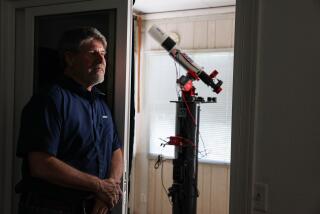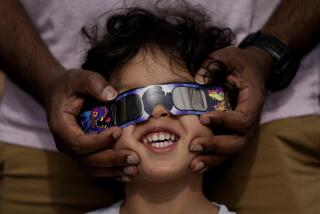Astronomy Club Sets Its Sights on the Stars
Does it seem as though the sky is a busy place these days? What with the comet Hyakutake cruising overhead and another comet, Hale-Bopp, on its way, the heavens are attracting a lot of attention.
You can find out what all the fuss is about Saturday when the Ventura County Astronomical Society celebrates National Astronomy Day. The club has two free events scheduled: a daytime fair of sorts and a nighttime âstar partyâ at the Moorpark College Observatory.
You donât have to be an astronomy whiz to enjoy this. In fact, the clubâs goal is to bring in more novice sky watchers, according to the clubâs Tim Robertson.
The daytime portion will be held from 10 a.m. to 3 p.m. in the parking lot of Sycamore Plaza, located near Cochran Street and Sycamore Drive in Simi Valley.
Off and on during the day, Robertson will offer a special treat for kids: a whiz-bang experiment that recreates a comet--basically a dirty snowball--by mixing dry ice, ammonia, dirt and a few other ingredients.
If you donât know Venus from the North Star and the sky appears to be just a mass of lights, youâll find help here. Club members will demonstrate how to make a star chart, a kind of road map to the skies that you hold up at night to locate constellations and other sky objects.
A special telescope will be set up for viewing the sun without eye damage. It has a filter that knocks out radiation. Looking through it youâll see sun spots and maybe some flares coming off the sun.
You can also view the latest shots from the Hubble telescope, and check out telescopes on display. The club has members who custom-make them.
If you are puzzled by the ruckus over Hyakutake, these sky buffs will explain it all. Better yet, if you come to the star party Saturday night at the college, you can see it yourself.
*
Star party is a bit of a misnomer. Itâs not a party in the traditional sense, but the star gazing runs from 7:30 to 10 p.m. and the mood is pretty loose. You can scan the sky through one of the 15 to 20 telescopes that members will set up outside. Or, you can crowd into the dome and take a turn at the in-house telescope. Someone from the club will make a short presentation, explaining what to look for.
âThere is always something going on in the sky,â Robertson said. And Hyakutake isnât the only comet out there now. There are actually 11, he explained.
The neat thing about Hyakutake is its brightness--the glowing blob can be seen with the naked eye. Hyakutakeâs orbit will bring it relatively close, to within 9.3 million miles of the Earth. Its core is only a few miles wide, but the cloud of evaporating ice and dirt that surrounds it stretches over a million miles.
The club, which includes 110 members, holds star parties twice a month: one at Mt. Pinos near Frazier Park, where city lights donât interfere with viewing, and another at the collegeâs observatory. They meet the third Friday of the month at 7:30 p.m. in the collegeâs science building, Room 202, usually to hear a speaker.
The club has a World Wide Web site on the Internet if you want to track its doings. The group also has a hot line.
âWeâre not a cliquish club,â Robertson said. âWe want to bring beginners in. We have a whole range of members, up to professional astronomers and some of the worldâs best astronomical photographers.â
DETAILS
* WHAT: National Astronomy Day.
* WHEN: Saturday. Daytime activities run 10 a.m. to 3 p.m.; star party from 7:30 to 10 p.m.
* WHERE: Daytime fair at Sycamore Plaza parking lot, near Cochran Street and Sycamore Drive, Simi Valley. Star party at Moorpark College Observatory, 7075 Campus Road, Moorpark.
* HOW MUCH: Free.
* FYI: Clubâs hot line recording is 529-7813.
More to Read
Sign up for The Wild
Weâll help you find the best places to hike, bike and run, as well as the perfect silent spots for meditation and yoga.
You may occasionally receive promotional content from the Los Angeles Times.






